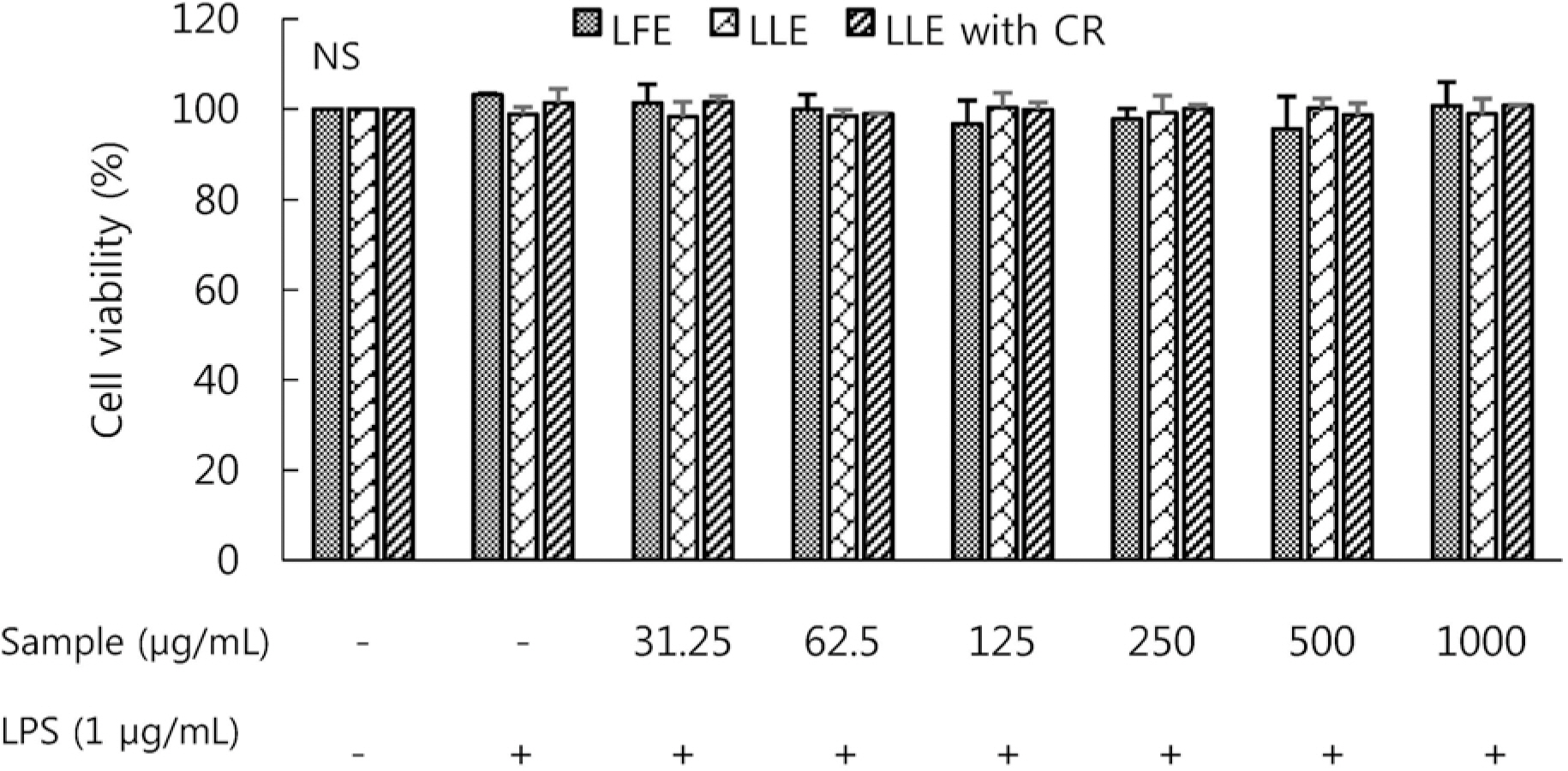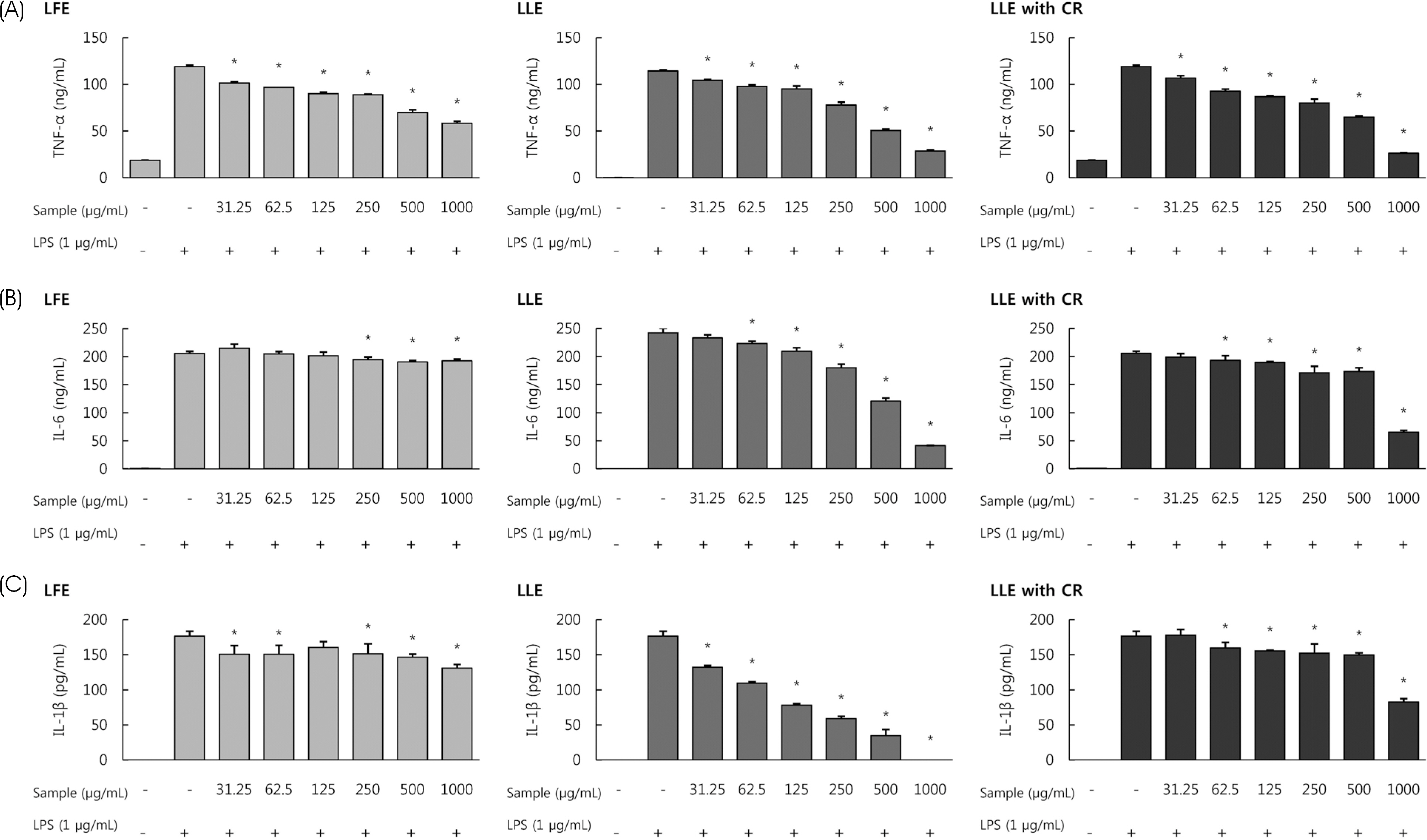J Nutr Health.
2019 Apr;52(2):129-138. 10.4163/jnh.2019.52.2.129.
Anti-inflammatory effects of fruit and leaf extracts of Lycium barbarum in lipopolysaccharide-stimulated RAW264.7 cells and animal model
- Affiliations
-
- 1Department of Food and Nutrition, Chungnam National University, Daejeon 34134, Korea. sunly@cnu.ac.kr
- 2Convergence Research Center for Natural Products, Chungnam National University, Daejeon 34134, Korea.
- KMID: 2444936
- DOI: http://doi.org/10.4163/jnh.2019.52.2.129
Abstract
- PURPOSE
Medicinal herbs have recently attracted attention as health beneficial foods and source materials for drug development. Recent studies have demonstrated that extracts of Lycium's fruits and roots have a range of physiologically active substances. The extract of Lycium's leaves has been reported to have excellent anti-oxidant and anti-microbial activity, but its anti-inflammatory efficacy is not known. The chlorophyll present in the leaves can act as an anti-oxidant or pro-oxidant depending on the presence of light. Therefore, this study analyzed the anti-inflammatory effects of Lycium's fruit extract (LFE), leaf extract (LLE), and leaf extract with chlorophyll removal (LLE with CR).
METHODS
This study examined the inhibitory effects of LFE, LLE, and LLE with CR on pro-inflammatory mediator production as well as on the expression of iNOS and COX-2 in lipopolysaccharide (LPS)-stimulated RAW264.7 cells and BALB/c mice.
RESULTS
LFE, LLE, and LLE with CR inhibited the production of pro-inflammatory mediators (NO, TNF-α, IL-6, and IL-1β) and the expression of iNOS and COX-2 in LPS-stimulated RAW 264.7 cells in a dose-dependent manner. Furthermore, the administration of LLE and LLE with CR inhibited the serum pro-inflammatory cytokine levels and suppressed DNA damage in BALB/c mice. In particular, LLE with CR exhibited the highest anti-inflammatory activity.
CONCLUSION
These results suggest that the fruit and leaves of Lycium are potential therapeutic agents against inflammation.
MeSH Terms
Figure
Reference
-
1.Zedler S., Faist E. The impact of endogenous triggers on trauma-associated inflammation. Curr Opin Crit Care. 2006. 12(6):595–601.
Article2.Isomäki P., Punnonen J. Pro- and anti-inflammatory cytokines in rheumatoid arthritis. Ann Med. 1997. 29(6):499–507.3.Vane JR., Mitchell JA., Appleton I., Tomlinson A., Bishop-Bailey D., Croxtall J, et al. Inducible isoforms of cyclooxygenase and nitric-oxide synthase in inflammation. Proc Natl Acad Sci U S A. 1994. 91(6):2046–2050.
Article4.Higuchi M., Higashi N., Taki H., Osawa T. Cytolytic mechanisms of activated macrophages. Tumor necrosis factor and L-arginine-dependent mechanisms act synergistically as the major cytolytic mechanisms of activated macrophages. J Immunol. 1990. 144(4):1425–1431.5.Nathan C. Nitric oxide as a secretory product of mammalian cells. FASEB J. 1992. 6(12):3051–3064.
Article6.Guzik TJ., Korbut R., Adamek-Guzik T. Nitric oxide and superoxide in inflammation and immune regulation. J Physiol Pharmacol. 2003. 54(4):469–487.7.Zhang R., Kang KA., Piao MJ., Kim KC., Kim AD., Chae S, et al. Cytoprotective effect of the fruits of Lycium chinense Miller against oxidative stress-induced hepatotoxicity. J Ethnopharmacol. 2010. 130(2):299–306.
Article8.Kim TS., Park WJ., Ko SB., Kang MH. Development of extracts of Lycii folium having high antioxidant activity. J Korean Soc Food Sci Nutr. 2008. 37(10):1318–1322.
Article9.Xiao J., Liong EC., Ching YP., Chang RC., So KF., Fung ML, et al. Lycium barbarum polysaccharides protect mice liver from carbon tetrachloride-induced oxidative stress and necroinfla-mmation. J Ethnopharmacol. 2012. 139(2):462–470.
Article10.Chen H., Olatunji OJ., Zhou Y. Anti-oxidative, anti-secretory and anti-inflammatory activities of the extract from the root bark of Lycium chinense (Cortex Lycii) against gastric ulcer in mice. J Nat Med. 2016. 70(3):610–619.
Article11.Luo Q., Cai Y., Yan J., Sun M., Corke H. Hypoglycemic and hypolipidemic effects and antioxidant activity of fruit extracts from Lycium barbarum. Life Sci. 2004. 76(2):137–149.
Article12.Mocan A., Vlase L., Vodnar DC., Bischin C., Hanganu D., Gheldiu AM, et al. Polyphenolic content, antioxidant and antimicrobial activities of Lycium barbarum L. and Lycium chinense Mill. leaves. Molecules. 2014. 19(7):10056–10073.13.Liu SC., Lin JT., Hu CC., Shen BY., Chen TY., Chang YL, et al. Phenolic compositions and antioxidant attributes of leaves and stems from three inbred varieties of Lycium chinense Miller harvested at various times. Food Chem. 2017. 215:284–291.
Article14.Albishi T., John JA., Al-Khalifa AS., Shahidi F. Antioxidative phenolic constituents of skins of onion varieties and their activities. J Funct Foods. 2013. 5(3):1191–1203.
Article15.Olatunde OO., Benjakul S., Vongkamjan K. Antioxidant and antibacterial properties of guava leaf extracts as affected by solvents used for prior dechlorophyllisation. J Food Biochem. 2018. 42(5):e12600.16.Park SH., Kim JM., Kim JH., Oh YS., Joo DH., Lee EY, et al. Antioxidative effects and component analysis of graviola (Annona muricata) leaf extract/fractions. J Soc Cosmet Sci Korea. 2017. 43(4):309–320.17.Kim JE., Bae SM., Nam YR., Bae EY., Ly SY. Antioxidant activity of ethanol extract of Lycium barbarum's leaf with removal of chlorophyll. J Nutr Health. 2019. 52(1):26–35.
Article18.Ko YE., Oh SR., Song HH., Ryu HW., Ly SY., Kim JW. The effect of 4α,5α-epoxy-10α,14-dihydro-inuviscolide, a novel immunosuppressant isolated from Carpesium abrotanoides, on the cytokine profile in vitro and in vivo. Int Immunopharmacol. 2015. 25(1):121–129.
Article19.Cho HY., Noh KH., Cho MK., Jang JH., Lee MO., Kim SH, et al. Anti-oxidative and anti-inflammatory effects of genistein in BALB/c mice injected with LPS. J Korean Soc Food Sci Nutr. 2008. 37(9):1126–1135.
Article20.Tice RR., Agurell E., Anderson D., Burlinson B., Hartmann A., Kobayashi H, et al. Single cell gel/comet assay: guidelines for in vitro and in vivo genetic toxicology testing. Environ Mol Mutagen. 2000. 35(3):206–221.
Article21.Oh YC., Cho WK., Im GY., Jeong YH., Hwang YH., Liang C, et al. Anti-inflammatory effect of Lycium fruit water extract in lipopolysaccharide-stimulated RAW 264.7 macrophage cells. Int Immunopharmacol. 2012. 13(2):181–189.
Article22.Cho EJ., Kim YE., Lee DE., Sung NY., Byun EH., Park WJ. Comparison of the antioxidative and anti-inflammatory activities of Lycium chinense leaves and fruits extracts according to the harvest time. J Korean Soc Food Sci Nutr. 2018. 47(7):717–724.
Article23.Vilcek J., Lee TH. Tumor necrosis factor. New insights into the molecular mechanisms of its multiple actions. J Biol Chem. 1991. 266(12):7313–7316.24.Olmos G., Lladó J. Tumor necrosis factor alpha: a link between neuroinflammation and excitotoxicity. Mediators Inflamm. 2014. 2014:861231.
Article25.Gabay C., Lamacchia C., Palmer G. IL-1 pathways in inflammation and human diseases. Nat Rev Rheumatol. 2010. 6(4):232–241.
Article26.Scheller J., Garbers C., Rose-John S. Interleukin-6: from basic biology to selective blockade of pro-inflammatory activities. Semin Immunol. 2014. 26(1):2–12.
Article27.Xie JH., Tang W., Jin ML., Li JE., Xie MY. Recent advances in bioactive polysaccharides from Lycium barbarum L., Zizyphus jujuba Mill, Plantago spp., and Morus spp.: structures and functionalities. Food Hydrocoll. 2016. 60:148–160.
Article28.Zhu J., Zhang Y., Shen Y., Zhou H., Yu X. Lycium barbarum polysaccharides induce Toll-like receptor 2- and 4-mediated phenotypic and functional maturation of murine dendritic cells via activation of NF-κB. Mol Med Rep. 2013. 8(4):1216–1220.
Article29.González-Gallego J., García-Mediavilla MV., Sánchez-Campos S., Tuñón MJ. Fruit polyphenols, immunity and inflammation. Br J Nutr. 2010. 104(Suppl 3):S15-S27.
Article30.Chapple IL. Reactive oxygen species and antioxidants in inflammatory diseases. J Clin Periodontol. 1997. 24(5):287–296.
Article31.Shibata H., Sakamoto Y., Oka M., Kono Y. Natural antioxidant, chlorogenic acid, protects against DNA breakage caused by monochloramine. Biosci Biotechnol Biochem. 1999. 63(7):1295–1297.
Article32.Benjakul S., Kittiphattanabawon P., Sumpavapol P., Maqsood S. Antioxidant activities of lead (Leucaena leucocephala) seed as affected by extraction solvent, prior dechlorophyllisation and drying methods. J Food Sci Technol. 2014. 51(11):3026–3037.
Article
- Full Text Links
- Actions
-
Cited
- CITED
-
- Close
- Share
- Similar articles
-
- Antioxidant activity of ethanol extract of Lycium barbarum's leaf with removal of chlorophyll
- Protective effect of Lycium barbarum leaf extracts on atopic dermatitis: in vitro and in vivo studies
- Antioxidant and anti-inflammatory effects and mechanism of Abeliophyllum distichum leaf extract in RAW264.7 macrophages
- Anti-Inflammatory Effects of Fermented Products with Avena sativa on RAW264.7 and HT-29 Cells via Inhibition of Inflammatory Mediators
- Protective effect of chlorophyllremoved ethanol extract of Lycium barbarum leaves against nonalcoholic fatty liver disease






